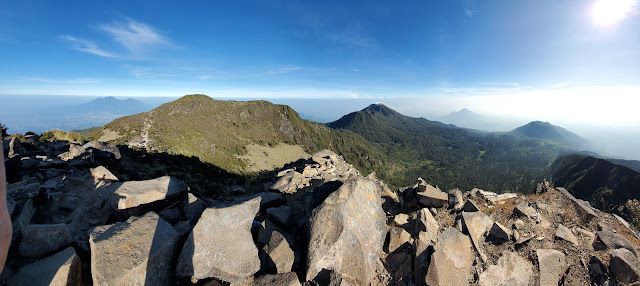Another year. And another volcano to hike.
Well, this time it would actually be two: the twin peaks of Mount Arjuno and Mount Welirang in East Java.
There are two main tracks leading up to the camp site located at a saddle between the two volcanoes, one from Tretes and the other from Batu. We would choose the latter as it is a relatively easier and shorter trek starting at a higher elevation (1,700m) - and that’s definitely not a bad thing at all!
This time, the trip would not be quite so easy to organise, however, as the bureaucracy involved in climbing Indonesian volcanoes has unfortunately increased in recent years. In the case of Arjuno-Welirang, online registration is even mandatory beforehand. And that’s a mountain to climb in itself, I can tell you, as their website is even more difficult to navigate than a huge Jakarta kampung walked through blindfold.
Another bureaucratic hurdle was having a letter from a doctor stating that one is healthy and fit enough to climb a volcano! This letter can be obtained from a puskesmas (govt run health clinic) or hospital after a cursory and basically pointless examination. Nonetheless, this takes time (plenty of waiting at the puskesmas), and I even had to take time off work as this particular service is only provided on weekdays. Arggghh! A proverbial pain in the arse, in other words, although not in the literal sense of course.
Volcano permit costs have also shot up in recent years across Indonesia and this is also the case for Arjuno where foreigners are expected to pay around 20x the local rate. Totally unfair but what can you do? It’s almost as if the authorities here don’t want foreigners to climb volcanoes. And maybe they don’t.
Getting to Batu from Jakarta is easy enough – either fly or take a train to Malang – and from there get a gocar or taxi the remaining way to a hotel if you don’t want to go directly to the base camp at Sumber Brantas where you have to complete the registration process for the hike.
Luckily, there is no need to begin the hike at the basecamp anymore. This is because a pretty decent road has recently been constructed for farmers to help them bring down their produce grown on the slopes of the mountain. By taking a motorcycle taxi (ojek) or one of the pickups waiting outside the basecamp up this road, you can easily reduce the hiking time by an hour or so – and conserve a lot of precious energy to boot!
It’s a pretty tough slog up the mountain but the distance between the posts is mercifully short. All in all, it took us about five hours to reach the camp site at Lembah Lengkean (2,911m). And that was with plenty of breaks. Not too bad at all!
Indonesian volcanoes are noted for their mysticism and Gunung Arjuno is no exception. This after all, is a volcano named after a hero in the Mahabharata epic, who is said to have meditated on the mountain to increase his supernatural powers, thus giving it its name today: Mount Arjuna or more commonly, Mount Arjuno.
What is strange on this mountain is the feeling that you are always being accompanied, even when alone. The birds are strangely unfazed by human contact and get very close. One hiker even said that when left hiking alone, a bird landed in front of her and steadily walked ahead, showing her the way.
The camp site basically sits on a saddle between the two volcanos, although the trek to the Arjuno summit (3,339m) is by far the more challenging with some parts of the trail very steep indeed at around 45 degrees. ‘Never again!’ I swore to myself. But when we reached the summit at around 8am after 4 hours of walking my mood quickly changed to elation of course!
The more interesting hike is to the peak of Welirang, in my opinion, as this volcano – unlike Arjuno – is still active with sulfur dioxide plumes a potential hazard at the summit.
Nonetheless, the views are magnificent from the peaks of both volcanoes if you have good weather, with Semeru, Raung, Argopuro and Lawu all visible.
So, another two volcanoes struck off the list.
But which one to climb next?




Comments
Post a Comment